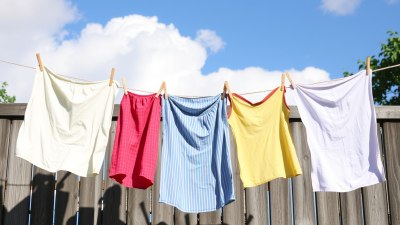How the Weather Decides When You’ll Finally Do the Laundry
Explore how weather patterns influence your laundry habits and the psychology behind procrastination tied to climate conditions.

Image created with Flux Schnell
Have you ever noticed that your laundry schedule seems to be at the mercy of the weather rather than your own planning? It's not just in your head; weather significantly influences when and how you decide to tackle this routine chore. From the sunshine that beckons you to hang your clothes outdoors to the dreary rain that keeps laundry baskets piling up, the climate plays a covert but powerful role in shaping your laundry habits.
Understanding the impact of weather on laundry is not only about managing your household tasks better but also about recognizing the deeper psychological effects of environmental conditions on motivation and behavior. Let’s delve into why weather matters so much in deciding when you finally get around to doing the laundry, and how you might gain control over this unpredictable influence.
The Psychological Impact of Weather on Motivation
Weather influences mood and energy levels, which in turn affect our willingness to undertake tasks, especially chores like laundry. Bright, sunny days are known to elevate mood by increasing serotonin production, making people more inclined to engage in productive activities. Conversely, gloomy, rainy, or cold days often lead to feelings of lethargy or low motivation, resulting in procrastination.
These psychological responses have a direct impact on laundry habits. When the sun shines, there's an almost innate urge to wash clothes and hang them outside, driven not only by the practical benefit of quick drying but also the mood boost from being outdoors. On dull days, the prospect of laundry often feels more burdensome, with people more likely to delay the task.
Seasonal Variations and Laundry Patterns
Seasonal weather changes also dictate laundry routines. In spring and summer, longer daylight hours and warmer temperatures make it easier and more appealing to wash clothes and air-dry them outdoors. The sunshine acts as a natural sanitizer and freshener, adding a sensory incentive to doing laundry.
Fall and winter present challenges; shorter days and cooler temperatures reduce natural drying efficiency. Rain and snow make outdoor drying impractical, pushing people to use indoor drying racks or dryers, which might be less convenient or energy-efficient, sometimes resulting in less frequent laundry sessions. Additionally, bulkier seasonal clothing requires different washing frequencies, further complicating routines.
Practical Considerations: Weather Forecasts as Laundry Guides
Many people subconsciously check the weather forecast before committing to laundry, integrating meteorological data into their decision-making process. A sunny forecast encourages “laundry days,” while predictions of rain or high humidity often prompt delays.
The use of modern technology, such as smartphone apps providing accurate weather updates, enables better planning. Some apps even offer dedicated modules or reminders suggesting ideal laundry times based on local climate conditions. Harnessing this information can reduce procrastination by reducing uncertainty and helping set realistic expectations for drying times.
Humidity: The Invisible Laundry Obstacle
Humidity—often overlooked when thinking about laundry—is a critical factor affecting drying times and fabric freshness. High humidity slows evaporation, forcing clothes to stay damp longer, which can cause musty smells and bacterial growth. This reality can discourage people from washing clothes during humid days or prompt them to use the dryer more frequently.
Conversely, low humidity environments accelerate drying, making outdoor drying even more efficient. Understanding local humidity patterns can help optimize laundry scheduling to improve results and reduce energy consumption.
Rain, Wind, and Their Interplay with Laundry Decisions
Rain is the most obvious weather deterrent for outdoor laundry as wet clothes don't dry; they only get wetter. Yet, light or intermittent rain, combined with wind, can sometimes create a false sense of drying efficiency. For example, windy conditions can hasten evaporation on clothes left outdoors after a brief shower, but wind without sunshine often isn't enough to fully dry fabric.
Many people adopt an all-or-nothing approach: they either wait for fully clear weather or opt for indoor drying solutions. This binary thinking stems from the uncertainty and inconvenience posed by unpredictable rain spells and fluctuating wind patterns.
Temperature’s Role Beyond Comfort
While warmer temperatures generally help clothes dry faster, extreme heat can sometimes damage delicate fabrics, prompting more cautious washing schedules. Cold weather extends drying times, often making indoor drying mandatory. As a result, laundry frequency may decrease to avoid accumulating damp clothes indoors, which could impair room humidity and cause other discomforts.
Temperature fluctuations during transitional weather periods—such as early spring or late autumn—make laundry planning particularly tricky, with a greater tendency to procrastinate until a more predictable stretch of weather arrives.
The Cultural and Social Dimensions of Weather-Influenced Laundry
In different cultures and climates, laundry practices vary widely, influenced by the typical weather patterns. For example, in tropical climates with frequent rainfall, indoor drying methods and quick turnaround washing machines are common. In contrast, in Mediterranean climates, outdoor drying is a tradition deeply tied to sunny weather.
The visibility of laundry in outdoor spaces also carries social and aesthetic implications. Bright, sun-dried clothes can evoke a sense of cleanliness and domestic pride, whereas prolonged laundry backlog may lead to embarrassment during social visits. These factors motivate many to coordinate laundry with optimal weather to maintain social harmony.
Addressing Laundry Procrastination: Strategies to Override Weather Dependence
Given the strong influence of weather on laundry habits, intentionally adopting strategies to counteract this dependence can increase productivity. Here are some effective approaches:
- Indoor Drying Solutions: Invest in quality drying racks, dehumidifiers, or heat-based dryers to minimize reliance on outdoor conditions.
- Weather Monitoring Tools: Use apps or alerts to seize optimal weather windows, reducing guesswork and last-minute delays.
- Scheduling Rituals: Create fixed laundry days in your routine that are adhered to regardless of minor weather fluctuations.
- Batch Laundry Systems: Accumulate laundry to wash on reliable weather days, improving efficiency.
- Mindset Shifts: Recognize procrastination triggers linked to weather and develop motivational techniques such as rewards or social accountability.
The Environmental Impact of Weather-Driven Laundry Timing
Timing laundry to align with favorable weather can reduce energy consumption by limiting dryer use. Drying clothes outdoors on sunny, windy days leverages natural resources, cutting electricity bills and environmental footprints.
However, erratic weather can force increased reliance on electric dryers or longer drying cycles, raising energy demand. Understanding and adapting laundry habits in response to climate patterns helps balance convenience and sustainability.
Future Perspectives: Technological Innovations and Weather-Adaptive Laundry
Advancements in smart home technology are paving the way for laundry systems responsive to weather conditions. Smart washers and dryers can adjust cycles based on humidity and temperature sensors, while automated drying systems optimize energy use.
Integration of weather data into home appliances promises a future where laundry is less dependent on external climate. For instance, robotic laundry systems might schedule washes during optimal humidity dips or automatically switch between indoor and outdoor drying setups.
How COVID-19 Altered Laundry and Weather Interactions
During the COVID-19 pandemic, increased time at home shifted many habits, including laundry routines. With more frequent clothing changes due to working from home and heightened hygiene awareness, laundry frequency increased. However, weather constraints remained, sometimes exacerbating frustration over drying clothes indoors without adequate ventilation.
This period also saw a surge in laundry technology adoption, such as faster washers and enhanced indoor drying solutions. The pandemic underscored the importance of decoupling laundry tasks from weather dependence to sustain household efficiency.
Psychological Tricks to Beat Weather-Linked Laundry Delays
Combatting the waiting game imposed by weather involves specific mental strategies. Visualization techniques—imagining the satisfaction of fresh, clean laundry—can motivate action even on less-than-ideal days. Setting micro-goals and rewarding progress encourage small wins over procrastination.
Another effective method is to reframe unfavorable weather not as a barrier but as an opportunity to experiment with indoor drying innovations or to clean other related items like curtains or rugs that don't require outdoor drying.
The Role of Climate Change in Future Laundry Habits
Climate change introduces new variables affecting laundry routines worldwide. Increased unpredictable weather patterns, hotter summers, and more frequent storms challenge traditional laundry scheduling. These shifts may force wider adoption of energy-intensive drying solutions or innovation in fabric technology to reduce washing frequency.
Long term, people will need to adapt habits to cope with less reliable sunshine and greater humidity. Sustainable laundry practices that minimize water and energy use while accommodating these new realities will become essential.
Weather’s Hidden Hand in Laundry Timing
Your laundry schedule is much more than a mundane task clocked independently from nature. It’s intricately tied to day-to-day weather fluctuations, seasonal cycles, and evolving environmental conditions. Recognizing this intertwined relationship offers practical benefits: improved planning, reduced procrastination, lower energy consumption, and enhanced well-being.
By understanding how weather impacts motivation, drying efficiency, and cultural habits, you can harness the power of climatic cues rather than be controlled by them. Combining awareness with technological tools and behavioral strategies empowers you to break free from weather dictation and keep your laundry moving smoothly—rain or shine.











